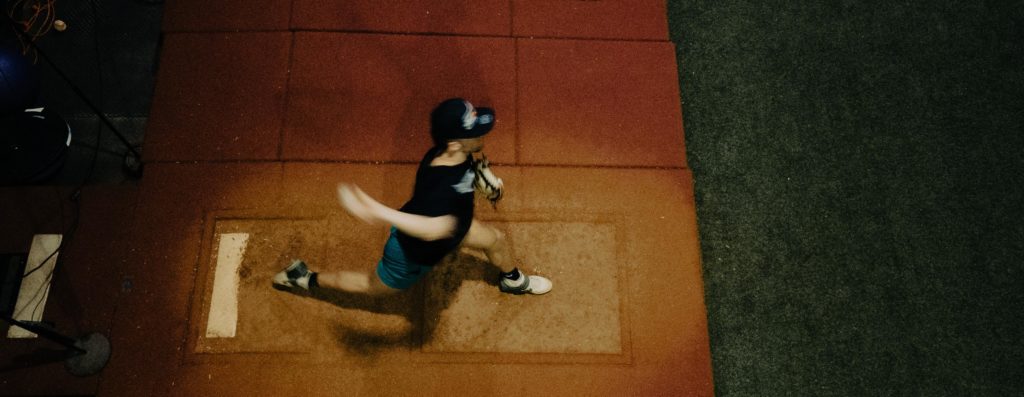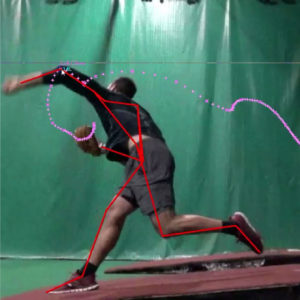
A popular and conventional topic of pitching mechanics is "Arm Path." This means the path the arm takes out of the glove into pitch release. Do you break your hands early or late? Do you swing the arm up or down? Do you through your elbows high or low? Do you break your arms hard or soft? Does any of this even matter?
The major issue with just coaching the "Arm Path" to increase pitching velocity is like telling the passenger in the car to start pushing the car so we can go faster. It is a backward approach to pitching velocity and like the passenger in the car, it is better to tell him to just hold on for the ride.
The High-Velocity Pitching Arm
The best way to truly understand the pitching arm of the high-velocity pitcher is to compare it to the end of a whip or the arm of the catapult. The arm is not the engine or the driving force. It is adding leverage to the movement and releases the ball for launch. It is a major misconception to believe that the arm is doing all of the work to generate the pitching velocity.
To help define the job of the pitching arm in the high-velocity pitcher, we must first define its major functions. The pitching arm serves three functions in high-velocity pitching delivery. Here is a list of these functions:
3 Functions of the Pitching Arm
- Holds the Ball and Releases the Pitch
- Guides the Pitch Toward the Target
- Assists Acceleration
The first two functions are self-explanatory but the third function bends the brain a bit. Yes, the arm assists acceleration by adding levers to the movement and it multiplies the effects of these levers with elasticity in the muscles. The high-velocity arm uses a more eccentric force when throwing the ball. This means a previous force put the arm into this passive stretched position before acceleration, similar to a whip or catapult. This is why the time it takes for Aroldis Chapman, the current hardest thrower in the game, to accelerate the arm and release the pitch is one-tenth of a second. This is the fastest body movement in all of the sports and it doesn't happen by contracting or swinging the arm to throw the ball.
To prove the lack of muscle activity in the throwing arm during acceleration here is a case study that used an EMG analysis to document the muscle activity of the throwing arm. The case study was called, An EMG analysis of the shoulder in throwing and pitching and it was performed by the legendary Jobe FW and his colleagues Tibone JE, Perry J, Moynes D. Here are the results of the study:
Five male subjects’ throwing and pitching motions were analyzed by dynamic electromyography and high speed photography. Electrodes inserted into the deltoid and rotator cuff muscles attempted to define muscle activation patterns during the throwing and pitching cycle. The wind-up or preparation (Stage I) had no consistent pattern. Cocking (Stage II) had a sequential muscle activation pattern of first deltoid activity, followed by the S.I.T. muscles and finally by the subscapularis muscle. Acceleration (Stage III) had a lack of muscle activity, even though the arm was accelerating forward in space. Follow-through (Stage IV) was the most active stage with all the muscles firing intensely. The muscle patterns observed during the cycle were largely characteristic of attempts to decelerate the arm.
Read the case study here: http://www.ncbi.nlm.nih.gov/pubmed/6829838
Arm Path to Increase Pitching Speed
 So if the arm must be stretched before it is fired, then what is the most effective "Arm Path" for the high-velocity pitcher? Ultimately the main job of the arm is to get into position for launch. This position happens at stride foot contact and the arm must be sitting in a relaxed position to allow for the stretching or external rotation of the throwing arm to follow, which is the eccentric movement that generates the energy to launch the arm into acceleration.
So if the arm must be stretched before it is fired, then what is the most effective "Arm Path" for the high-velocity pitcher? Ultimately the main job of the arm is to get into position for launch. This position happens at stride foot contact and the arm must be sitting in a relaxed position to allow for the stretching or external rotation of the throwing arm to follow, which is the eccentric movement that generates the energy to launch the arm into acceleration.
To truly understand this positioning of the throwing arm at the front foot strike, you must have a good understanding of the high-velocity pitcher. In the 3X Pitching Mechanics the high-velocity delivery is first divided into two phases; the Throwing Phase and the Stride Phase. This is a critical perspective to grasp because it is the most powerful way to simply define the difference between the high velocity to the low-velocity pitcher. This is because the low-velocity pitcher does not separate these phases as well as the high-velocity pitcher.
The Stride Phase is defined as starting with the First Move and ending at the front foot strike or stride foot contact. The Throwing Phase is defined as beginning at front foot strike or stride foot contact and ending at pitch release. Why it can simply be called the Throwing Phase because at front foot strike or stride foot contact the throwing arm is in the cocked position and sitting behind the head in line with the glove shoulder pointing towards the target. It is important to note that the arm of the high-velocity pitcher is in a relaxed state in this position and is waiting to be activated. The low-velocity pitcher has already activated the arm in this position.
The reason the high-velocity pitcher puts the throwing arm in this relaxed position and is separating these two phases is that he is waiting for the hips to open toward the target. This early hip rotation of the high-velocity pitcher at the front foot strike will launch the shoulders toward the target if the back shoulder and arm are in position and relaxed. The more relaxed, the greater the stretch, first in the core and following into the arm as it externally rotates. Here is an excellent article to learn more about this hip-to-shoulder separation and how 3X enhances it.
If the throwing arm takes an aggressive path from hand break to the cocked position, then there is a good chance that the throwing arm will not be relaxed at the front foot strike. This is why 3X Pitching does not advise you to swing the arm or control the arm path from hand break to the cocked position. All that is important is that when the front foot lands the throwing arm is cocked, relaxed, and ready to launch.
Now that the throwing arm is cocked, relaxed, and ready to launch, we must understand what is the most efficient "Arm Path" to effectively enhance pitching velocity. A recent case study discovered the "Arm Path" of the high-velocity pitcher from this cocked position to pitch release. Here is the "Arm Path" results from the case study called, Relationships between ball velocity and throwing mechanics in collegiate baseball pitchers.
Ball velocity was most affected by the time from stride foot contact (SFC) to maximum shoulder external rotation (MER), elbow angle at SFC, MER, elbow extension angular velocity,...
Ball velocity would be increased by: (1) a shorter interval from SFC to MER; (2) increased elbow flexion at SFC; (3) increased maximum shoulder external rotation; (4) increased elbow flexion angular velocity.
Read a summary of the case study here: http://www.ncbi.nlm.nih.gov/pubmed/18707902
If you would like to read the entire case study please contact me.
This case study teaches us that once the throwing arm is cocked, relaxed, and ready, the arm must also have good elbow flexion. This elbow flexion means the ball is inside the elbow. This will allow the arm to move into external rotation faster because of the shorter arm path due to the increased elbow flexion. This will also support the case studies' findings of the high-velocity pitcher moving into maximum external rotation at stride foot contact faster than the low-velocity pitcher. It will also support the other finding of elbow extension angular velocity because when the arm is moving faster into MER then the elastic energy is greater, so the arm will then launch into elbow extension faster as it releases the pitch.
Notice these findings of the "Arm Path" of the high-velocity pitcher are not supported by early hand breaks, high elbows swings, behind-the-back swings, long arm paths, pulling the ball down through acceleration, etc. The "Arm Path" of the high-velocity pitcher is a hand break into a cocked and relaxed throwing arm position at stride foot contact with a low elbow and elbow flexion of fewer than 90 degrees. Following hip-to-shoulder separation, the arm must stay relaxed as it pulls back into MER while it also moves into good shoulder abduction before launch. If all of this occurs at a high rate of speed, the arm will move into elbow extension with a high rate of angular velocity before pitch release and pitching velocity are enhanced.
3X Pitching Trains the High-Velocity Arm Path
The 3X Pitching Velocity Program is most effective in increasing pitching velocity when implemented in its entirety. The 3X Velocity System is a proprietary throwing program that uses a 2lb medicine ball and a baseball to perform the 2, 3 part series of 3X drills. These drills were developed to support the motor coordination of the 3X Pitching Mechanics which is the model of the high-velocity pitcher. These mechanics along with all of the drills, exercises, and lifts from the revolutionary pitching velocity program will not only teach you what it takes to become a high-velocity pitcher, but it will train you to become one. Check out the 3X Pitching Velocity Program TODAY!


